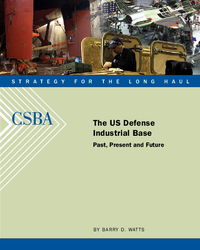
The emergence, during the presidency of Dwight Eisenhower, of a peacetime defense industry of significant proportions was an unprecedented event in the history of the American republic. Two geopolitical developments made its emergence more or less unavoidable for a nation committed to leadership of the Free World after World War II. One was the onset of the US-Soviet Cold War in the late 1940s and the formulation, in response, of the strategy of trying to contain Soviet power. The other was North Korea’s invasion of South Korea in June 1950, which precipitated the large increases in defense spending called for in Paul Nitze’s formulation of containment in April 1950. The standing military-industrial complex that these developments brought into being endures to this day.
Since the 1950s, the US defense industrial base has been a source of long-term strategic advantage for the United States, just as it was during World War II. American defense companies provided the bombers and missiles on which nuclear deterrence rested and armed the US military with world-class weapons, including low-observable aircraft, wide-area surveillance and targeting sensors, and reliable guided munitions cheap enough to be employed in large numbers. They also contributed to the development of modern digital computers, successfully orbited the first reconnaissance satellites, put a man on the moon in less than a decade, and played a pivotal role in developing the worldwide web.
Critics have long emphasized President Eisenhower’s warning in his farewell television address that the nation needed to “guard against the acquisition of undue influence, whether sought or unsought, by the military-industrial complex.” Usually forgotten or ignored has been an earlier, equally important, passage in Eisenhower’s January 1961 speech:
A vital element in keeping the peace is our military establishment. Our arms must be mighty, ready for instant action, so that no potential aggressor may be tempted to risk his own destruction.



























